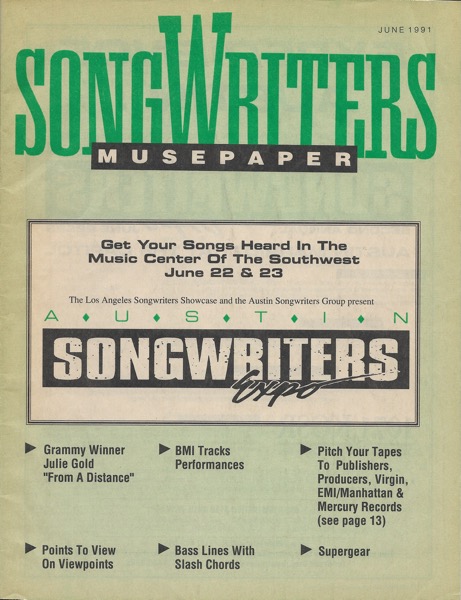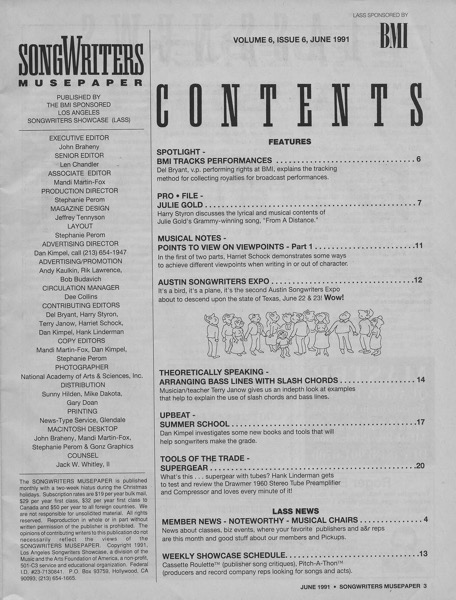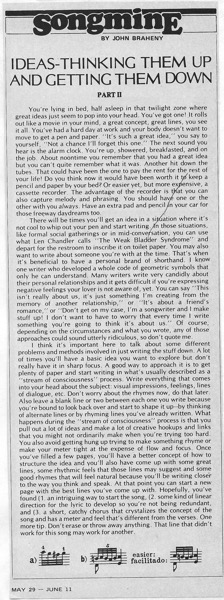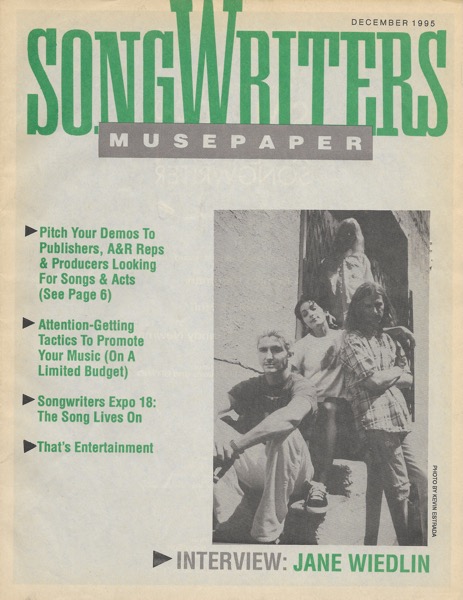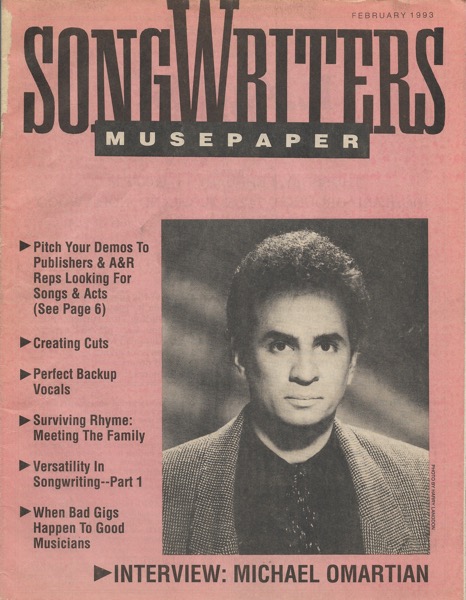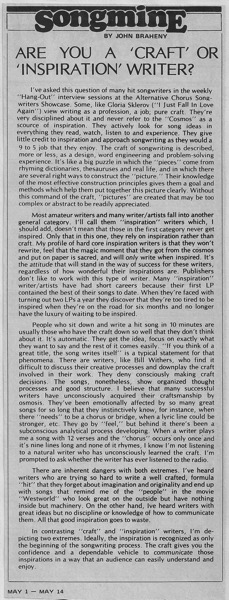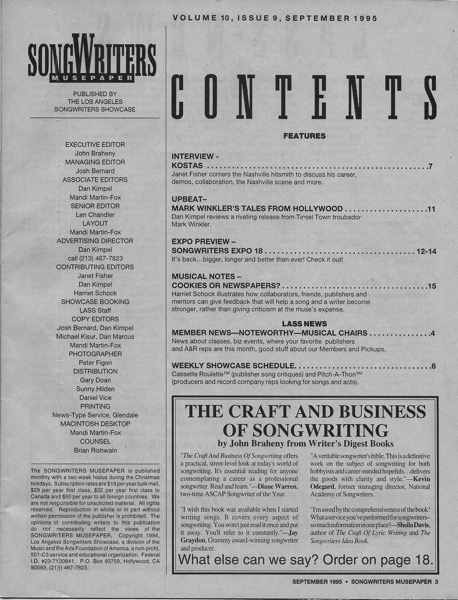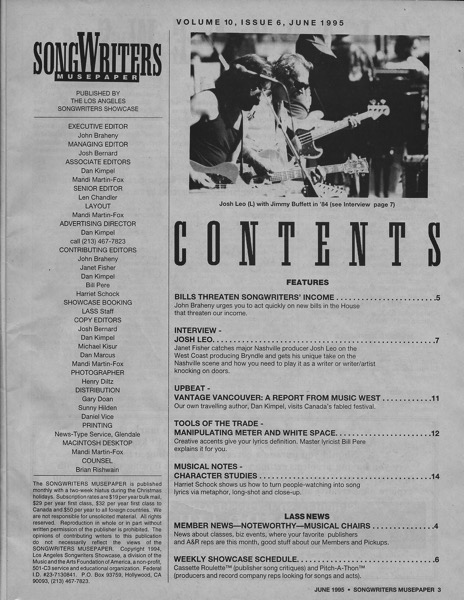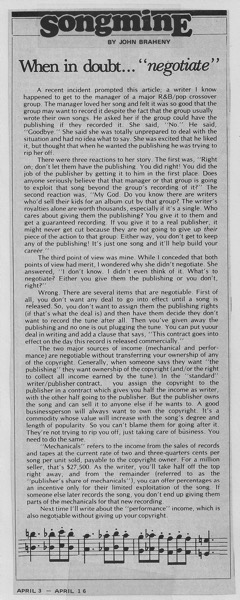A John Braheny Songmine column from the archives…
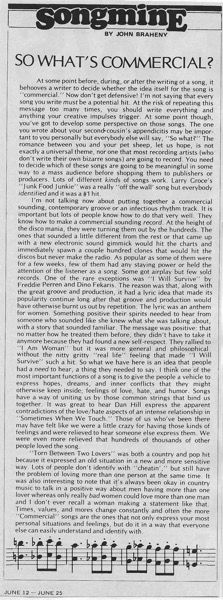
Accession Number: C000000137-032-001 Document/Digital File, “Songmine: So What’s Commercial? by John Braheny by John Braheny”, OCR converted text under same Accession Number
(Digitally converted text. Some errors may occur)
Songmine BY JOHN BRAHENY
SO WHAT’S COMMERCIAL?
At some point before, during, or after the writing of a song, it behooves a writer to decide whether the idea itself for the song is “commercial.” Now don’t get defensive! I’m not saying that every song you write must be a potential hit. At the risk of repeating this message too many times, you should write everything and anything your creative impulses trigger. At some point though, you’ve got to develop some perspective on those songs. The one you wrote about your second- cousin’s appendicitis may be impor- tant to you personally but everybody else will say, “So what?” The romance between you and your pet sheep, let us hope, is not exactly a universal theme, nor one that most recording artists (who don’t write their own bizarre songs) are going to record. You need to decide which of these songs are going to be meaningful in some way to a mass audience before shopping them to publishers or producers. Lots of different kinds of songs work. Larry Groce’s ” J unk Food Junkie” was a really “off the wall’ song but everybody identified and it was a #1 hit.
I’m not talking now about putting together a commercial sounding, contemporary groove or an infectious rhythm track. It is important but lots of people know how to do that very well. They know how to make a commercial sounding record. At the height of the disco mania, they were turning them out by the hundreds. The ones that sounded a little different from the rest or that came up with a new electronic sound gimmick would hit the charts and immediately spawn a couple hundred clones that would hit the discos but never make the radio. As popular as some of them were for a few weeks, few of them had any staying power or held the attention of the listener as a song. Some got airplay but few sold records. One of the rare exceptions was “I Will Survive” by Freddie Perren and Dino Fekaris. The reason was that, along with the great groove and production, it had a lyric idea that made its popularity continue long after that groove and production would have otherwise burnt us out by repetition. The lyric was an anthem for women. Something positive their spirits needed to hear from someone who sounded like she knew what she was talking about, with a story that sounded familiar. The message was positive: that no matter how he treated them before, they didn’t have to take it anymore because they had found a new self-respect. They rallied to “I Am Woman” but it was more general and philosophical. without the nitty gritty “real life” feeling that made “I Will Survive” such a hit. So what we have here is an idea that people had a need to hear, a thing they needed to say. I think one of the most important functions of a song is,to give the people a vehicle to express hopes, dreams, and inner conflicts that they might otherwise keep inside; feelings of love, hate, and humor. Songs have a. way of uniting us by those common strings that bind us together. It was great to hear Dan Hill express the apparent contradictions of the love/hate aspects of an intense relationship in “Sometimes When We Touch.” Those of us who’ve been there may have felt like we were a little crazy for having those kinds of feelings and were relieved to hear someone else express them. We were even more relieved that hundreds of thousands of other people loved the song.
“Torn Between Two Lovers” was both a country and pop hit because it expressed an old situation in a new and more sensitive way. Lots of people don’t identify with “cheatin’,” but still have the problem of loving more than one person at the same time. It was also interesting to note that it’s always been okay in country music to talk in a positive way about men having more than one lover whereas only really bad women could love more than one man and I don’t ever recall a woman making a statement like that. Times, values, and mores change constantly and often the more “Commercial” songs are the ones that not only express your most personal situations and feelings, but do it in a way that everyone else can easily understand and identify with.
JUNE 12 -JUNE 25
See all previous entries in the Songmine Series
About Songmine and Music Connection Magazine:
John Braheny met Eric Bettelli and Michael Dolan right before they were going to publish Music Connection magazine. Eric and Michael wanted to get their publication out to as many songwriters as they could. They had already heard of the LA Songwriters Showcase, and of John and his partner, Len Chandler. John’s goal was to advertise the schedule of guest speakers and performers at the weekly Showcase… so they made a deal.
They published John’s Songmine column (he had never before written a magazine article!) in their very first edition, in November 1977. Trading out the column for advertising, this arrangement continued for many years. Plus, Eric and Michael came to the Showcase each week and distributed free copies to the songwriters!
Those articles became so popular that (book agent and editor) Ronny Schiff offered John’s articles to F&W Media, where they became the backbone of John’s textbook, The Craft and Business of Songwriting. As a follow-up, Dan Kimpel (author, songwriter, teacher), who had also worked at LASS, took on the Songwriting column at Music Connection magazine which continues to this day! You can subscribe to get either hard copies or online.
